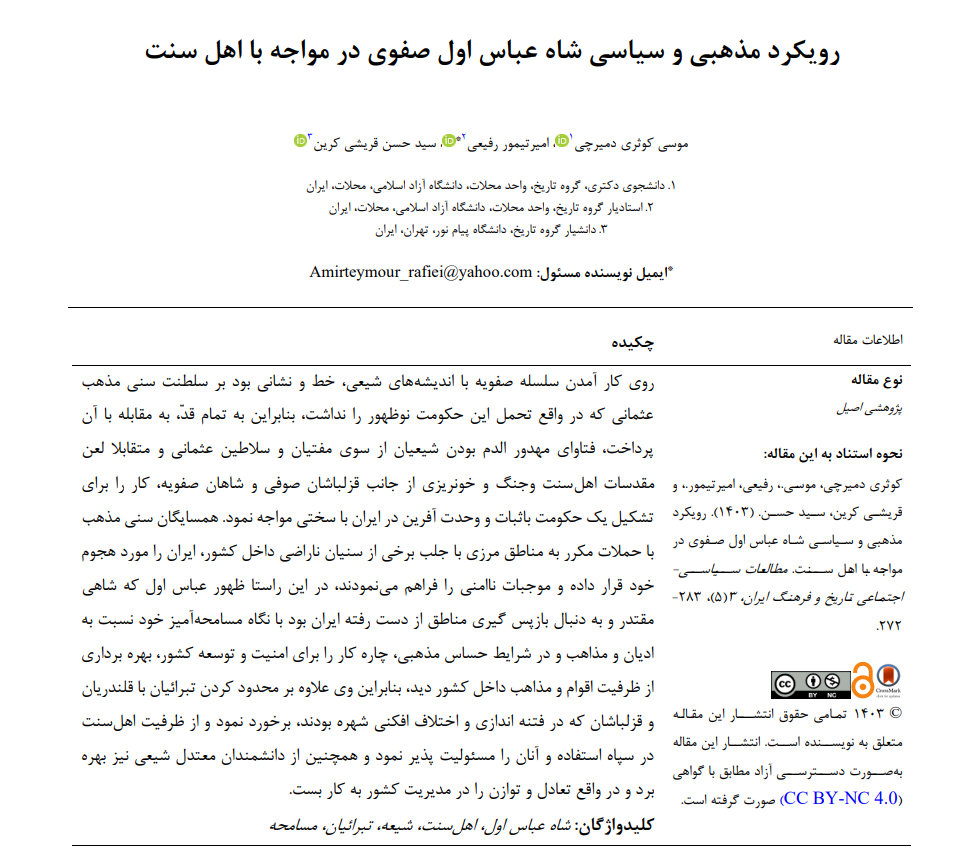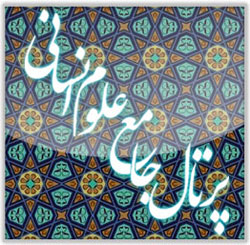رویکرد مذهبی و سیاسی شاه عباس اول صفوی در مواجه با اهل سنت
کلمات کلیدی:
شاه عباس اول, اهلسنت, شیعه, تبرائیان, مسامحهچکیده
روی کار آمدن سلسله صفویه با اندیشههای شیعی، خط و نشانی بود بر سلطنت سنی مذهب عثمانی که در واقع تحمل این حکومت نوظهور را نداشت، بنابراین به تمام قدّ، به مقابله با آن پرداخت، فتاوای مهدور الدم بودن شیعیان از سوی مفتیان و سلاطین عثمانی و متقابلا لعن مقدسات اهلسنت وجنگ و خونریزی از جانب قزلباشان صوفی و شاهان صفویه، کار را برای تشکیل یک حکومت باثبات و وحدت آفرین در ایران با سختی مواجه نمود. همسایگان سنی مذهب با حملات مکرر به مناطق مرزی با جلب برخی از سنیان ناراضی داخل کشور، ایران را مورد هجوم خود قرار داده و موجبات ناامنی را فراهم مینمودند، در این راستا ظهور عباس اول که شاهی مقتدر و به دنبال بازپس گیری مناطق از دست رفته ایران بود با نگاه مسامحهآمیز خود نسبت به ادیان و مذاهب و در شرایط حساس مذهبی، چاره کار را برای امنیت و توسعه کشور، بهره برداری از ظرفیت اقوام و مذاهب داخل کشور دید، بنابراین وی علاوه بر محدود کردن تبرائیان با قلندریان و قزلباشان که در فتنه اندازی و اختلاف افکنی شهره بودند، برخورد نمود و از ظرفیت اهلسنت در سپاه استفاده و آنان را مسئولیت پذیر نمود و همچنین از دانشمندان معتدل شیعی نیز بهره برد و در واقع تعادل و توازن را در مدیریت کشور به کار بست.
دانلودها
مراجع
Afandi, A. b. I. B. (2010). Riyadh al-Ulema wa Hiyadh al-Fozala (Gardens of Scholars and Pools of the Virtuous) (Translated by M. Bagher Saedi Khorasani ed., Vol. 3). Mashhad: Astan Quds Razavi, Islamic Research Foundation.
Ajan, Y., & Espenaghchi Pashazadeh, M. A. b. M. S. (2001). History of Iran, Safavid Period The Islamic Revolution Between the Elite and the Common People (Translated from the Cambridge University Press Compiled by R. Jafarian ed.). Tehran: Jami Qom: Dalil Publications.
Bartold, V. V. (1996). The Place of the Areas Around the Caspian Sea in the History of the Islamic World (Translated by L. Raban Shah ed.). Tehran: Institute for Humanities and Cultural Studies.
Della Valle, P. (2005). The Travels of Pietro Della Valle (Translated by Shoja' al-Din Shafa ed.). Tehran: Sherkat-e Entesharat-e Elmi va Farhangi.
Eskandar Beyg Monshi, T. (2003). Tarikh-e Alam Aray-e Abbasi (History of the World-Adorning Abbasid)VL - 1, 2, & 3 (Edited and with an introduction by I. Afshar ed.). Tehran: Amir Kabir.
Etemad al-Saltaneh, M. H. b. A. (1988). Mirat al-Buldan (Mirror of the Lands) (Edited by H. Mohaddeth & A. Hossein Navai ed., Vol. 4). Tehran: University of Tehran.
Falsafi, N. (1974). Zendegani-ye Shah Abbas-e Awal (The Life of Shah Abbas I) (Vol. 3). Tehran: University of Tehran.
Falsafi, N. (1992). Zendegani-ye Shah Abbas-e Awal (The Life of Shah Abbas I) (Vol. 1 & 2). Tehran: Elmi Publications.
Ghadiani, A. (2008). Farhang-e Jame-ye Tarikh-e Iran (Comprehensive History of Iran) (Introduction by G. Reza Vatan Dust ed., Vol. 2). Tehran: Aron.
Grantovsky. (1980). Tarikh-e Iran az Zaman-e Bastan ta Emruz (History of Iran from Ancient Times to the Present) (Translated by K. Keshavarzi ed.). Tehran: Pouyesh.
Jafarian, R. (2000). The Safavids in the Field of Religion, Culture and Politics (Vol. 1 & 2). Qom: Research Institute of Hawza and University.
Jafarian, R. (2008). History of Shi'ism in Iran. Tehran: Nashr-e Elm.
Lockhart, L. (2004). The Fall of the Safavid Dynasty (Translated by E. Dolatshahi ed.). Tehran: Sherkat-e Entesharat-e Elmi va Farhangi.
Mahdavi, M. (2007). A'lam-e Esfahan (Celebrities of Isfahan) (Edited by G. Reza Nasrallahi Introduction by M. A. Chalongar ed., Vol. 4). Isfahan: Isfahan Municipality, Cultural and Recreational Organization.
Mir Mohammad Sadegh, S. S. (2003). Sar Gozasht-e Shah Abbas-e Awal (The Story of Shah Abbas I) (Vol. 1). Tehran: Ahl-e Ghalam Publications.
Monajem, M. J. (1987). Tarikh-e Abbasi ya Ruznameh-ye Mola Jalal (History of Abbasi or Journal of Mullah Jalal) (Edited by S. Vahidnia ed.). Tehran: Vahid PublicationsER -.
Monshi Qomi, A. b. H. (2004). Khulasat al-Tawarikh (Summary of Histories) (Edited by E. Eshraghi ed., Vol. 1). Tehran: University of Tehran, Institute of Publications and Printing.
Olivier, G. A. (1992). Voyage d'Olivier (Olivier's Travels) (Translated by M. Taher Ghajar ed.). Tehran: Ettela'at.
Raben, K. M. (1970). The System of Provinces in the Safavid Period (Translated by K. Jahandari ed.). Tehran: Sherkat-e Entesharat-e Elmi va Farhangi.
Rabino, H. L. (1995). Velayat-e Dar al-Marz of Iran (Translated by Jafar Khamami Zadeh ed.). Rasht: Ta'ati Publications.
Ravandi, M. (1975). Tarikh-e Ejtema'i-ye Iran (Social History of Iran) (Vol. 2, 3, 4, & 8). Tehran: Amir Kabir.
Savory, R. (2005). Iran Under the Safavids (Translated by K. AziziPB - Tehran: Nashr-e Markaz ed.).
Sefatgol, M. (2010). The Structure of Religious Institutions and Thought in Safavid Iran. Tehran: Rasa.
Shirley, A. (2008). The Travels of the Shirley Brothers (Translated by H. Massiyan Compiled by A. Dehbashi ed.). Tehran: Negah Publications.
Tajbakhsh, A. (1999). History of the Safavids. Shiraz: Navid Shiraz.
Zaki Beyg, M. A., & Sanandaji, S. b. A. (2002). Zobdat al-Tarikh-e Kurd va Kurdistan (The Essence of the History of Kurds and Kurdistan) Tohfeh-ye Naseri dar Tarikh va Joghrafia-ye Kurdistan (Naseri's Gift on the History and Geography of Kurdistan) (Translated by Y. Roshan Ardalan Edited by H. Tabibi ed., Vol. 1 & 2). Tehran: Toos Tehran: Amir Kabir.








